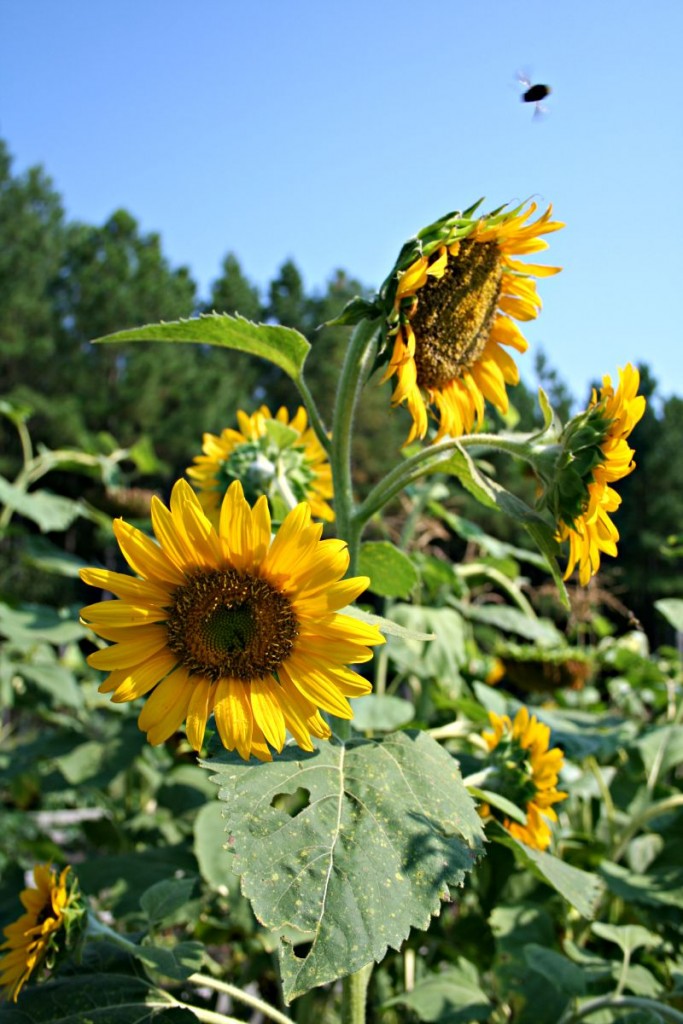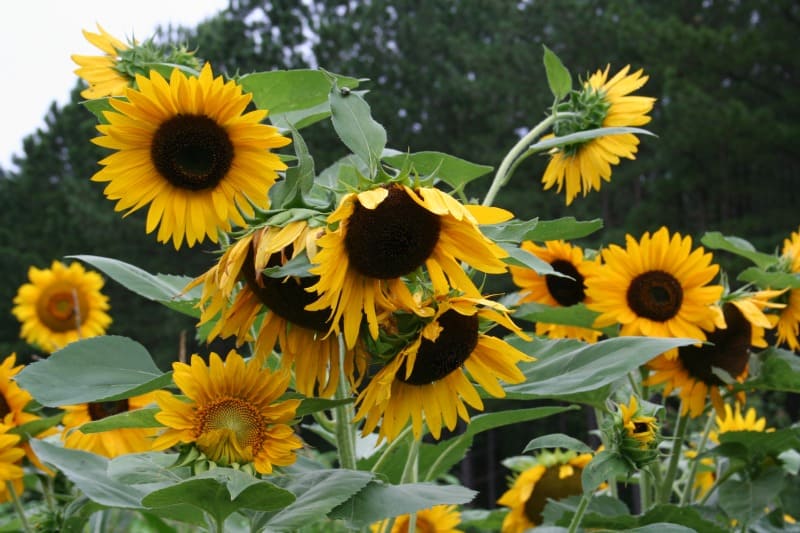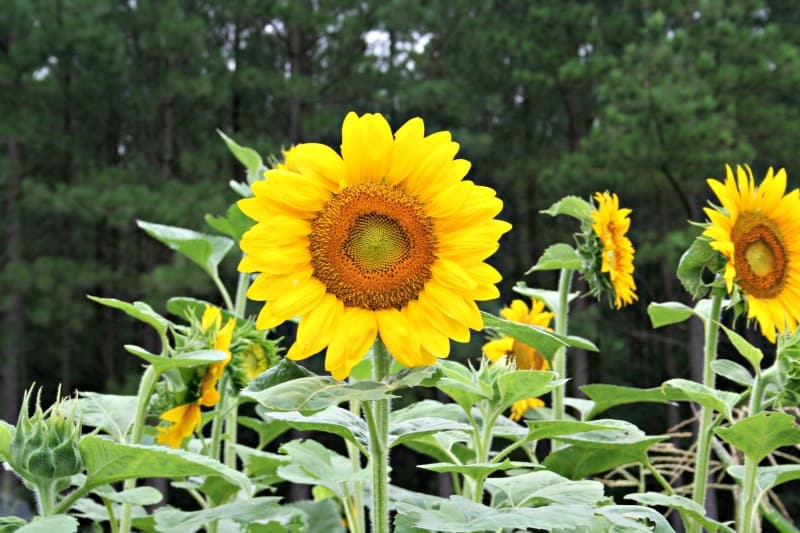Growing sunflowers isn’t hard to do, but you do need to outwit the local wildlife intent upon eating your sunflower seeds!

Growing Sunflowers in the Home Garden
Assuming you don’t have a hungry chipmunk, you can grow sunflowers in the home garden. You can grow them for their beauty, to use them as cut flowers, or to save the seeds for your own consumption or to fill your bird feeder. I save the seeds to plant them again the following spring. I also use some in the bird feeder during the harshest winter months. I find that the birds seem to relish the fresh sunflower seeds. My guess is that the oils are more plentiful in the fresh seeds, or maybe they taste better. Can birds taste???
Growing Sunflowers from Seed
Growing sunflowers from seed is the best way to add them to the garden. Sunflowers can be sown as soon as the last danger of frost for your region has passed. It’s best to plant the seeds directly into the ground where you want the plants to grow; they dislike being moved.
Make sure you plant them in an area where they have room to grow. Most sunflowers are quite tall, towering over your head at six, seven feet or taller! The Russian Giant or Mammoth sunflowers are exceptionally tall with huge flower heads. The heads are heavy once the seeds mature, so planting sunflowers near a fence or wall is also advised. They can lean on the support once the seeds mature and weigh down the flower head.
Sowing Sunflower Seeds
Use a trowel and dig a little hole in the ground about an inch deep. Just pop the seed in, cover, and water. That’s it. Space them about eight inches apart or more.
Light Requirements
Sunflowers absolutely require full, bright, direct sunlight, so make sure you plant them in a sunny area. They can withstand drought and seem to prefer long, hot summers.
Pests
Deer, squirrels, chipmunks and birds love the seeds. If you plant a lot of sunflowers, some seeds will remain to save. I find that Japanese beetles also eat the petals, which is a shame, but if you stagger your seed planting you can have a continuous field of sunflowers and outwit the beetles. Plant seeds at two to four week intervals until the 4th of July or a little later for the southern areas of the country. New flowers will emerge after the old ones are spent, and hopefully you can have some flowers in the garden after the pesky beetles are done devouring everything.
Fertilizer and Water
I don’t bother fertilizing or water the sunflowers once they’re up. Mine are growing along the hottest side of our house. It’s a stucco wall facing the south – and I live in Virginia. The soil is very poor too in that area but the sunflowers don’t seem to care. They do get some added water because I’ve planted them near the spigot where we attach the hose, and we drain the hose in that area, which waters them a bit. They also have mulch to help the soil retain water.
Drying Sunflower Seeds
To dry sunflower seeds to use in the garden, the bird feeder or for human consumption, wait until the sunflowers become dry and the petals turn brown or fall off. The heads will droop on the stalks. If you look closely at the inflorescence, each seed will be noticeably fat and striped. It’s time to harvest them.
Cut off the seed heads and spread them out on top of newspapers in a hot, dry location. I use my garage. I’ve done this two ways. Sometimes I just place the sunflowers in a cardboard box. The box catches any seeds that fall out of the flower; they will start falling out when they dry out. You can then save the seeds to plant next year or use in your bird feeder.

Another way is to leave a portion of the stem in place and hang it upside down to dry out. Put a pail or a box underneath, as some seeds do drop. You can also slip a paper bag over the sunflowers before hanging them upside down to catch the seeds. Tape the top of the bag shut over the seed head.
When the entire flower is dry, use your fingers to break apart the dried sunflower head. Most seeds will fall out on their own, but you may need to pick some out. You can shell them and eat the kernels, or place the new seeds in jars to plant next year. You can also pour them into your bird feeder for a treat for your feathered friends. But don’t put them on the ground. Not unless you want a big, fat chipmunk in the yard….
Types of Sunflowers
There are many types of sunflowers. The traditional giant yellow petals surrounding a dark disk are traditional Mammoth Giant or Russian Giant sunflowers. Bronze, yellow, mixed colors, reds, and dwarf sunflowers are all available.
Interesting Facts About Sunflowers
Some sunflower facts and fun:
- Did you know that each seed, each dot on the big old seed head of a sunflower is actually a flower in and of itself? What we call the “flower” on a sunflower is actually a huge cluster of tiny flowers. The group is called an inflorescence.
- Sunflower inflorescence is arranged with natural, mathematical precision in a Fibbonachi sequence. (Lovers of The Big Bang Theory, ask Sheldon what that means).
- Scientists who make solar panels study sunflowers to learn the most efficient method of arranging panels to capture the sun. They’ve found that by far the most efficient method of panel arrangement is how nature made the sunflower.
- Sunflowers do follow the sun through a process called heliotropism. The stems, leaves and flower turn slowly to follow the sun throughout the growing period to maximize photosynthesis. Because of heliotropism, they actually achieve 10-15% more photosynthesis than if they sat still. Once the seeds mature, the plant halts in place in the best location to sunbathe.
- Sunflower plants can actually clean pollutants from soil and water. Tests have shown they can clean lead, radioactive materials and possibly other pollutants from the ground.
The most beautiful sight I have ever seen was South Dakota in early August. We were driving along the highway through the sunflower fields. Miles upon miles, hour after hour, nothing but blooming sunflowers. It was stunning. That night, we ate in a tiny truck stop diner in South Dakota, and every man there talked about the price of sunflower seeds and oil.
We often forget that flowers grown for their beauty in the home garden also serve practical needs. Sunflowers are one of the most beautiful, useful plants around.
Garden Journal: My Experience Growing Sunflowers
When I lived in Huntington, Long Island, my father-in-law loved to plant sunflowers along the brick border by the back patio. He wondered why few of them germinated, and fewer still made it to maturity.
One day, my husband and I were sitting on the back patio, enjoying a lovely summer day. A flurry of rust-brown fur near the downspout from the rainwater gutters made me do a double take. Something scurried out of the drainpipe, ran to the newly planted sunflower seeds, and started to dig. We moved slowly so as not to scare the critter. Peering over the edge of the brick, we saw a chipmunk furiously digging in the moist soil. As soon as he found the sunflower seeds, he popped them into his mouth, scurried back to the drain pipe, deposited the seed, and hastened back to his treasure-trove of seeds.
No wonder my father-in-law’s sunflowers never sprouted! We had THE fattest chipmunk I’ve ever seen by the end of the summer.
This post was first publishing in July 2014. It was updated on June 17, 2021 with new information, new text and new formatting.






I learned there are native to North America, but were discovered, found their way to Europe and Asia where they were bred. They became popular, and then were later ‘imported’ to North America.
-Ray
I also found that different birds like different sunflower seeds. One variety was scarfed up by the chickadees, but the cardinals wouldn’t touch them. But, the variety I grew last year are loved by the cardinals.
I’ve tried to grow sunflowers here, but they never seem to take. I so wish I could get them to in the mountains! #HomeMattersParty
Sunflowers are so beautiful. My son and I found some growing along side the highway for miles, we really loved looking at them. I really like your interesting facts! I didn’t know anything about sunflowers. #HomeMattersParty
Sunflowers are so beautiful! Thank you for sharing these great tips! #HomeMattersParty
These are some great tips about growing sunflowers. Your interesting facts are really interesting to know. Sunflowers always makes me feel happy.
This is so interesting. I had a sunflower field in my childhood home growing up, but I didn’t appreciate them near enough back then. They are truly beautiful!
I do like to eat sunflower seeds too! There are so many great recipes for them.
Thank you for sharing this with us on the #HomeMattersParty. I’m glad that we co-host it together.
I remember Rory trying to grow some in our backyard when she was younger. They never grew and we had no idea why. Years later we found out that the Brazilian Pepper trees, that grew ten feet from where we had planted them, are actually invasive and don’t allow other plants to grow! Let’s hope you don’t have the same plight anytime soon!
With gardening, there are always surprises….! Our sunflowers are along the south side of the house as well as in the open fields, so I think we’re good. Thanks for stopping by!